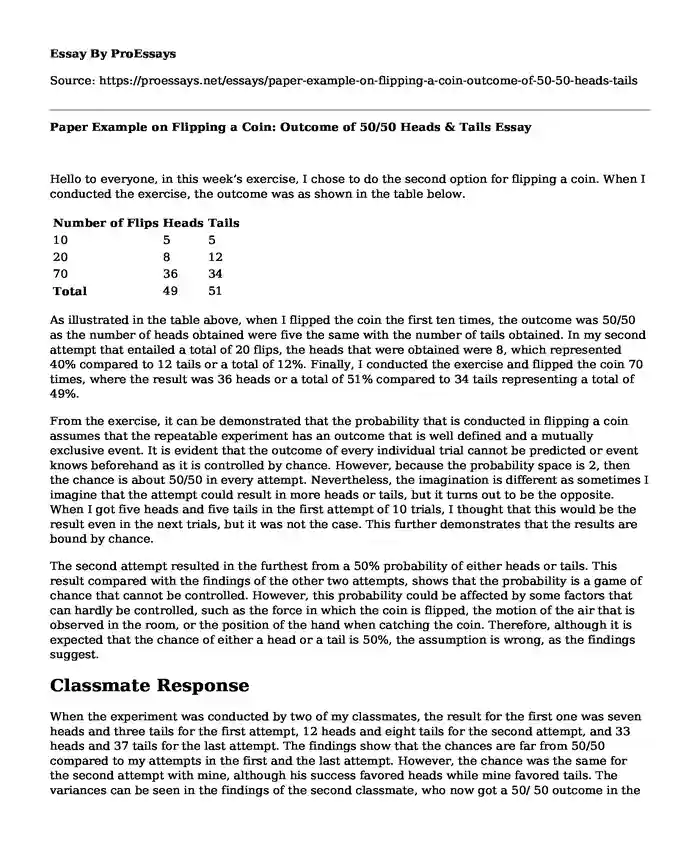Hello to everyone, in this week’s exercise, I chose to do the second option for flipping a coin. When I conducted the exercise, the outcome was as shown in the table below.
| Number of Flips | Heads | Tails |
| 10 | 5 | 5 |
| 20 | 8 | 12 |
| 70 | 36 | 34 |
| Total | 49 | 51 |
As illustrated in the table above, when I flipped the coin the first ten times, the outcome was 50/50 as the number of heads obtained were five the same with the number of tails obtained. In my second attempt that entailed a total of 20 flips, the heads that were obtained were 8, which represented 40% compared to 12 tails or a total of 12%. Finally, I conducted the exercise and flipped the coin 70 times, where the result was 36 heads or a total of 51% compared to 34 tails representing a total of 49%.
From the exercise, it can be demonstrated that the probability that is conducted in flipping a coin assumes that the repeatable experiment has an outcome that is well defined and a mutually exclusive event. It is evident that the outcome of every individual trial cannot be predicted or event knows beforehand as it is controlled by chance. However, because the probability space is 2, then the chance is about 50/50 in every attempt. Nevertheless, the imagination is different as sometimes I imagine that the attempt could result in more heads or tails, but it turns out to be the opposite. When I got five heads and five tails in the first attempt of 10 trials, I thought that this would be the result even in the next trials, but it was not the case. This further demonstrates that the results are bound by chance.
The second attempt resulted in the furthest from a 50% probability of either heads or tails. This result compared with the findings of the other two attempts, shows that the probability is a game of chance that cannot be controlled. However, this probability could be affected by some factors that can hardly be controlled, such as the force in which the coin is flipped, the motion of the air that is observed in the room, or the position of the hand when catching the coin. Therefore, although it is expected that the chance of either a head or a tail is 50%, the assumption is wrong, as the findings suggest.
Classmate Response
When the experiment was conducted by two of my classmates, the result for the first one was seven heads and three tails for the first attempt, 12 heads and eight tails for the second attempt, and 33 heads and 37 tails for the last attempt. The findings show that the chances are far from 50/50 compared to my attempts in the first and the last attempt. However, the chance was the same for the second attempt with mine, although his success favored heads while mine favored tails. The variances can be seen in the findings of the second classmate, who now got a 50/ 50 outcome in the second attempt that entailed a total of 20 attempts. His last attempt demonstrated a similar probability chance with mine, although his attempt favored tails while mine favored heads. As such, the demonstration from my attempts compared with that of my classmates shows that flipping a coin is a game of chance or probability, and the outcome can be either way.
Cite this page
Paper Example on Flipping a Coin: Outcome of 50/50 Heads & Tails. (2023, Oct 04). Retrieved from https://proessays.net/essays/paper-example-on-flipping-a-coin-outcome-of-50-50-heads-tails
If you are the original author of this essay and no longer wish to have it published on the ProEssays website, please click below to request its removal:
- Why Abolishment of Examinations in Schools is Necessary
- Literature Review Example on In-Service Teacher Training (INSETT) Programs
- Impact of Technology on Toddlers - Essay Sample
- Essay Sample on School Principal's Responsibility for Student Safety in Learning Institution
- Essay Example on Honors vs Regular Students: Engagement & Self-Handicapping.
- Life's Lessons: Our Unexpected Teachers - Essay Sample
- Reconsidering the Electoral College: Challenges to Democracy and Calls for Reform - Essay Sample







